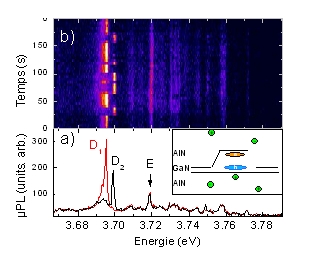Rechercher
Accueil > La Recherche > Axes & Equipes > Physique de l’Exciton, du Photon & du Spin > Technologies Quantiques à l’Etat Solide > Thème : Puits et Boites Quantiques
GaN/AlN quantum dots
publié le
Since 2004 we have developed a micro-photoluminescence (µPL) setup dedicated to the study of isolated nano-objects in the UV range (ACI BUGATI). We obtained important results on the spectroscopy of isolated GaN/AlN quantum dots. We first evidenced the major role of spectral diffusion on the inhomogeneous broadening of the transitions. The control of such spurious processes is especially important for prospects in single photon sources or coupling of a single dot to a photonic mode. Morever we measured and explained their polarization properties, which reflect the fine structure of excitonic complexes. The linear polarization degree, up to 90%, is much stronger than the one of InAs or CdTe quantum dots due to the specific band structure of GaN.

G. Cassabois, recently recruited as a professor in the group, and E. Rousseau, new CNRS researcher, are starting a new activity in 2010. The project consists in developing intraband optical spectroscopy in single GaN/AlN quantum dots embedded in nanowires. Single quantum dot optical spectroscopy is so far bound to the study of interband transitions, for which the high radiative efficiency makes luminescence experiments a powerful technique. In the case of intraband transitions, the poor quantum efficiency and the extension of the spectral domain in the mid or long-infrared make intraband optical spectroscopy in single quantum dots a very original but challenging task. The motivation for working with the GaN/AlN system is the recent observation in such quantum dots of intraband transitions at exceptionally short wavelengths, in the telecommunications spectral range around 1.55 µm. Two-color pump-probe experiments in the near-infrared range will be performed in order to study single GaN/AlN quantum dots embedded in nanowires.








